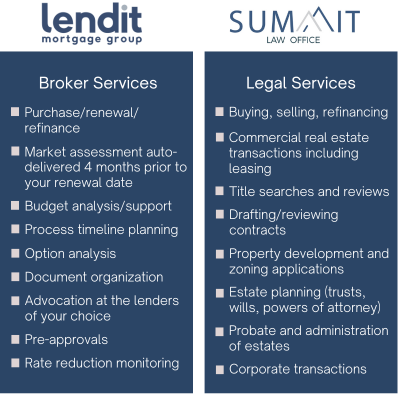What’s the rate??? Well, that depends….. There are a number of factors that determine what interest rate applies to a particular mortgage scenario. Below are details of some factors to consider:
Property Value and Purchase Price
This is the price you pay, or the appraised value, whichever is lower, for the property being mortgaged. The cost of the home affects the loan-to-value ratio (LTV). Homes over one million dollars cannot be insured or insurable, meaning they automatically fall into the conventional category, which typically comes with higher interest rates. High-priced homes also carry more risk for lenders due to potential market volatility, especially in BC’s more expensive regions such as Greater Vancouver.
Loan-to-Value Ratio (LTV)
LTV is calculated as (Mortgage Amount ÷ Property Value) × 100%. For example, if you buy a one million dollar home with a two hundred thousand dollar down payment, your mortgage is eight hundred thousand, so your LTV is 80%. High LTVs above 80% require mortgage default insurance, usually from CMHC, Sagen, or Canada Guaranty. Lower LTVs below 80% signal lower lender risk and may qualify for better rates, but only if the mortgage still fits “insurable” criteria. The LTV category determines whether your mortgage is insured, insurable, or conventional, which directly impacts the rate class.
Mortgage Type: Insured, Insurable, or Conventional
Insured Mortgage
This is a high-ratio mortgage (LTV over 80%) that requires mortgage default insurance, usually purchased by the borrower.
Requirements:
* Property must be owner-occupied.
* Maximum purchase price is one million dollars.
* Maximum amortization is 25 years.
* Borrower must meet the stress test.
Because the mortgage is insured against default, the lender’s risk is minimal, allowing them to offer the lowest possible rates, often 0.10%–0.30% lower than conventional rates.
Insurable Mortgage
A low-ratio mortgage (LTV 80% or less) that qualifies for insurance but doesn’t require the borrower to pay for it. The lender may insure it at their own cost.
Requirements:
* Owner-occupied.
* Purchase price less than or equal to one million dollars.
* Maximum amortization of 25 years.
Insurable mortgages usually get mid-tier rates—slightly higher than insured but better than conventional—because lenders can securitize these loans, lowering their funding costs.
Conventional (Uninsurable) Mortgage
Any mortgage that does not qualify for mortgage insurance. Examples include properties over one million dollars, refinances, amortizations over 25 years, rental or investment properties, and unconventional properties such as acreages or mixed-use buildings. Because these loans cannot be insured or securitized, the lender bears full risk, resulting in higher interest rates, often 0.30%–0.80% above insured rates.
Credit Score and Borrower Profile
Your credit score and credit history reflect your borrowing habits, payment reliability, and overall financial health. A credit score above 680–700 generally qualifies for prime lender rates. Lower scores may lead to higher rates, more restrictive terms, or placement with alternative lenders. Lenders also review income stability, debt service ratios (GDS/TDS), and employment length.
Property Type and Use
The physical and functional characteristics of the property—detached house, condo, duplex, townhouse, or rental property—impact the rate. Owner-occupied properties have lower risk. Investment or rental properties carry higher risk and therefore higher rates. Condos may have higher premiums depending on the strata’s financial health. Unique or rural properties have limited resale markets and therefore increased lender risk.
Amortization Period
This is the total time to fully pay off your mortgage. Typically this is 25 or 30 years.
A 30-year amortization comes with a higher rate. Longer amortizations mean more interest over time and greater lender risk.
Rate Type and Term
Fixed rates are based on bond yields, while variable rates are tied to the lender’s prime rate. The term length also affects pricing; longer terms generally carry slightly higher rates because of greater interest rate risk for the lender.
Lender Type and Funding Source
Different lenders have different funding models.
Big banks offer stability but may not always have the lowest rates.
Monoline lenders such as RMG, MCAP, First National, or CMLS often offer lower rates on insured or insurable loans because they securitize them.
Credit unions may have more flexible qualification criteria but sometimes higher posted rates.
Location and Market Conditions
Properties in strong, liquid markets are easier to resell, which lowers lender risk and can mean better rates. Remote or rural properties may face higher rates or stricter lending limits. Overall economic trends—Bank of Canada policy, bond yields, and liquidity—also shape available rates.
A capable mortgage broker will easily and quickly be able to provide you the lenders and rates that best suit your circumstances, saving you a ton of time calling around to all the lenders asking a long list of questions. Additionally, brokers have access to rate promotions not available directly to the public, so there’s even more benefit to utilizing their *free service.
*A consumer does not pay a fee for the advice or rates available to a mortgage broker. Each lender pays the mortgage broker a commission, which is disclosed in our signing package prior to funding.






 Porting your mortgage should be easy – but that’s not always the case! In the last three months, I have had two clients come to me asking for help because they wanted to port their mortgages but weren’t feeling confident about the transaction and the support they were getting from their banks…. One client had just renewed his mortgage just under a year ago and specifically went with the lender he did because he was able to get a line of credit for a future deposit and he was assured he could port his mortgage when he was ready to upsize his home for his growing family. Given the timeframes involved, both clients decided to switch to a new lender, even if the rate was slightly higher, because they could sleep at night knowing with certainty what the terms of the mortgage would be and that the financing would be in place when they needed it.
Porting your mortgage should be easy – but that’s not always the case! In the last three months, I have had two clients come to me asking for help because they wanted to port their mortgages but weren’t feeling confident about the transaction and the support they were getting from their banks…. One client had just renewed his mortgage just under a year ago and specifically went with the lender he did because he was able to get a line of credit for a future deposit and he was assured he could port his mortgage when he was ready to upsize his home for his growing family. Given the timeframes involved, both clients decided to switch to a new lender, even if the rate was slightly higher, because they could sleep at night knowing with certainty what the terms of the mortgage would be and that the financing would be in place when they needed it.